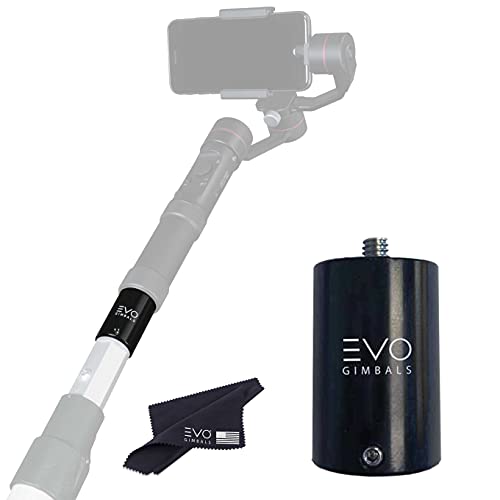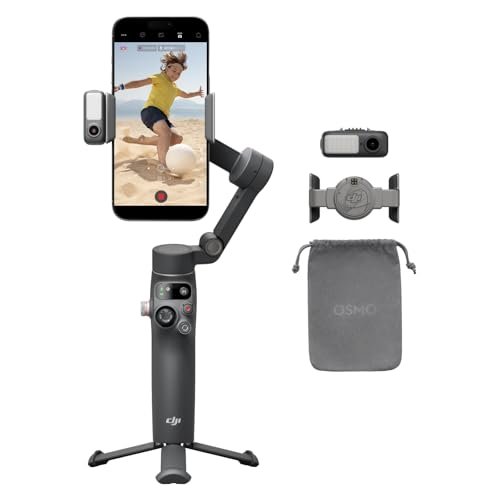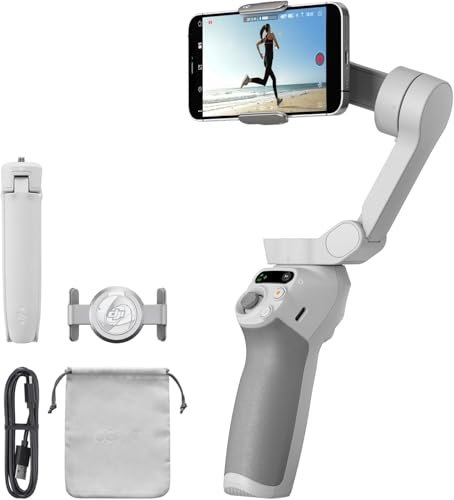Getting buttery-smooth, cinematic footage is a dream for many creators, and a reliable gimbal paired with the best DSLR for gimbal use is often the go-to setup. While your camera and stabilizer do most of the heavy lifting, there are clever accessories out there that can truly revolutionize your workflow, offering unique perspectives and practical solutions you might not have considered.
Choosing the ideal DSLR for a gimbal often involves balancing weight, video features, and native image stabilization (or lack thereof). Once you’ve got your perfect rig, these handy tools can elevate your shooting experience, helping you capture those tricky shots or just make your life a whole lot easier on set.
Let’s dive into some fantastic accessories that can seriously boost your filmmaking game!
EVO Gimbals PA-100 Painter’s Pole to 1/4-20 Tripod Thread Adapter

Ever wished you had a full-blown jib or crane for those high-angle shots without breaking the bank or your back? The EVO Gimbals PA-100 Painter’s Pole Adapter is an ingenious little tool that transforms everyday household items into powerful filmmaking aids. Imagine getting stunning aerial views over a crowd or replicating those dramatic crane shots, all by simply attaching your gimbal or camera to a standard painter’s pole or broom handle. It’s incredibly simple, yet opens up a world of creative possibilities for filmmakers using even the best DSLR for gimbal setups, allowing you to achieve perspectives that would otherwise require much more expensive and cumbersome gear.
-
Key Features:
- Transforms telescoping paint poles/broom handles into a camera jib arm/monopod.
- Mounts gimbal or camera directly with 1/4-20 tripod thread.
- Enables capture of aerial crowd photos & videos without a drone.
- Replicates cinematic jib-arm or crane-style moves when paired with a handheld gimbal.
- Supports up to 5.5lbs payload.
- Compatible with most EVO Gimbals, Zhiyun Smooth Q, Q2, X Series, Crane M2, Crane, DJI Osmo, Moza, most DSLR, Mirrorless & Action Cameras.
- Compact dimensions: 28mm (dia) x 43mm L, 1/4-20 Thread Length: 6mm.
-
Pros:
- Cost-effective way to achieve high-angle and jib shots.
- Extremely portable and easy to set up.
- Versatile, compatible with a wide range of gimbals and cameras.
- Lightweight and durable design.
-
Cons:
- Painter’s pole or broom handle not included (you’ll need your own).
- Might feel less stable than a dedicated, heavier jib arm for very precise movements.
-
User Impressions:
Customers rave about how this small adapter unlocks huge creative potential. Many highlight its simplicity and effectiveness for getting shots that would otherwise be impossible without significantly more expensive equipment. It’s often praised as a must-have for independent filmmakers and vloggers looking to expand their shot repertoire.
EVO Gimbals 31mm 3K Carbon Fiber Extension Pole Set

Sometimes, you just need a little more reach. Whether you’re trying to get above a crowd, achieve a low-angle tracking shot, or just want a more comfortable grip for your gimbal, the EVO Gimbals Carbon Fiber Extension Pole Set is a game-changer. Constructed from ultra-lightweight and strong 3K carbon fiber, these poles are not only incredibly durable but also waterproof and they even float! This makes them ideal for adventurous creators, allowing you to take your camera (and that best DSLR for gimbal setup) into various environments without worry, capturing unique perspectives on land or near water.
-
Key Features:
- Constructed from ultra-lightweight 3K Carbon Fiber.
- Intended for medium weight point & shoot cameras, action cameras, smartphones, and small handheld gimbal stabilizers under 7 lbs.
- Standard 1/4-20 interlocking threaded male & female ends for multi-set connection.
- Waterproof and designed to float.
- Great for achieving crane-style jib shots or elevated photos/video.
- Can connect many different accessories and cameras.
- Specifications: Material: 3K Matte Carbon Fiber; Size: 1.22″ x 13.8″ (31mm x 350mm); Mount: 1/4-20 male / female threading.
- Max length when connected: 700mm (27.8″).
- Includes 2 poles per set.
-
Pros:
- Extremely lightweight and durable carbon fiber construction.
- Waterproof and floats, ideal for outdoor and water-based shooting.
- Modular design allows for custom lengths.
- Versatile, works with various cameras and gimbals.
-
Cons:
- Payload limit of 7 lbs, so might not suit the heaviest DSLR + lens combinations when extended fully.
- Requires careful handling to avoid accidental drops when fully extended.
-
User Impressions:
Users love the portability and robustness of these poles. Their waterproof nature and ability to float are frequently cited as major advantages for shooting near water. Many appreciate the modular design, allowing them to customize the length for specific shots, making their best DSLR for gimbal setup even more adaptable.
Andoer RGB Camera Light, Dimmable LED Camera Fill Light

Good lighting is paramount for good video, no matter how good your camera or gimbal is. The Andoer RGB Camera Light is a compact yet powerful solution to ensure your subjects are always well-lit and vibrant. Beyond just providing a bright fill light, its RGB mode lets you add creative color splashes to your scenes, setting mood or highlighting specific elements. Its thoughtful design, including a built-in magnet and back bracket, offers incredible flexibility for placement, meaning you can easily position it for optimal lighting without needing to hold it. This is a fantastic companion for anyone looking to get the absolute best DSLR for gimbal footage possible, especially in challenging lighting conditions.
-
Key Features:
- Multi-functional with seven modes: 3200K-4000K-4800K-5600K-6500K (bi-color), SOS, and RGB mode.
- 1/4 screw hole design for compatibility with tripods or camera cold shoe adapters.
- Back bracket for stable surface placement.
- Built-in magnet for adsorption onto any metal surface.
- Built-in 4500mAh rechargeable battery for ultra-long life.
- Charges via Type-C cable.
- Wide applications: suitable for wild shooting, stage, party, emergency, dinner, and more.
-
Pros:
- Versatile lighting options with bi-color and RGB modes.
- Excellent battery life.
- Flexible mounting options (1/4″ thread, bracket, magnet).
- Compact and portable for on-the-go shooting.
- Adds a professional touch to video and photography.
-
Cons:
- Brightness might be limited for very large or brightly lit scenes.
- Might require an additional cold shoe adapter for direct camera mounting (if not using a cage/rig).
-
User Impressions:
Customers are highly impressed with the versatility and brightness packed into such a small light. The RGB functionality is a particular hit for adding creative flair, and the magnetic mounting option is often praised for its convenience. The long-lasting battery also makes it a favorite for extended shoots, complementing any best DSLR for gimbal setup.
Frequently Asked Questions (FAQs)
Q1: What makes a DSLR the “best DSLR for gimbal” use?
A1: The “best DSLR for gimbal” often refers to cameras that balance weight (not too heavy for the gimbal’s payload limit), offer good internal video stabilization or have highly effective lens-based stabilization, and boast strong video features like high frame rates, log profiles, and external recording capabilities. Ergonomics and battery life also play a big role.
Q2: Do all DSLRs work with any gimbal?
A2: No, not all DSLRs work with any gimbal. Gimbals have specific payload capacities, meaning they can only support a certain weight. You need to ensure your DSLR (plus lens and any accessories like external mics) falls within your gimbal’s maximum payload. Compatibility charts provided by gimbal manufacturers are crucial to check.
Q3: Why do I need a gimbal for my DSLR?
A3: A gimbal provides advanced stabilization, eliminating camera shake and creating incredibly smooth, professional-looking video footage. While some DSLRs have in-body stabilization, a gimbal offers superior 3-axis stabilization, essential for dynamic shots like walking, running, or panning.
Q4: Can these accessories be used with mirrorless cameras too?
A4: Absolutely! Most of these accessories, especially the extension poles and lights, are universally designed with standard 1/4-20 screw threads, making them compatible with a wide range of cameras, including mirrorless cameras, action cameras, and even smartphones (with appropriate adapters).
Q5: How does the Painter’s Pole Adapter help with my DSLR gimbal setup?
A5: The Painter’s Pole Adapter lets you extend your reach significantly. This is invaluable for getting elevated shots over crowds, mimicking professional crane or jib movements, or achieving unique angles that are impossible to get handheld. It expands the creative possibilities of your best DSLR for gimbal rig without needing large, expensive equipment.
Q6: Are carbon fiber extension poles durable enough for DSLRs?
A6: Yes, 3K carbon fiber is known for being incredibly strong and lightweight. While these specific poles are designed for “medium weight” cameras and gimbals up to 7 lbs, they are certainly durable enough for many DSLR setups, especially when used within their specified payload limits. They’re built to withstand regular use and even offer waterproof capabilities.
Q7: Is the RGB camera light powerful enough for outdoor night shoots with a DSLR?
A7: While the Andoer RGB light is versatile and powerful for its size, its primary use would be as a fill light or for creative accent lighting in outdoor night shoots, not as a primary light source for illuminating large areas. For extensive illumination outdoors, you’d typically need larger, more powerful lighting setups. However, for close-up shots, interviews, or adding mood, it’s very effective.
Conclusion
Having the best DSLR for gimbal isn’t just about the camera body itself; it’s also about optimizing your entire setup with the right tools. From getting those impossible high-angle shots with a simple adapter to extending your reach with a carbon fiber pole, or adding professional lighting with an RGB panel, these accessories can truly unlock new creative avenues. Investing in these clever additions will not only enhance your footage but also make your filmmaking process smoother and more enjoyable. So go ahead, experiment, and make every shot count!


